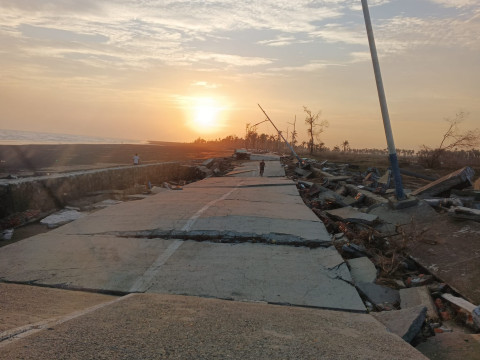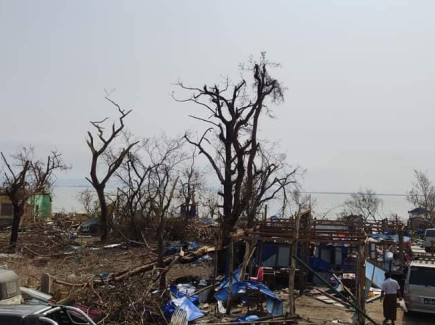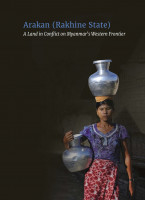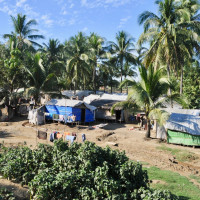The Strike of Cyclone Mocha and the Fate of Arakan People A Myanmar Commentary by Naing Lin
On 14 May 2023, Cyclone Mocha hit the coast of Arakan (Rakhine State) with devastating consequences. Bangladesh was also struck but the greatest impact was felt in Myanmar where the military State Administration Council was badly prepared. In this commentary, Naing Lin examines the backdrop to the cyclone, steps taken by the ceasefire United League of Arakan, and uncertainty over the loss of life, including Rohingya fatalities. The situation remains grave. But access continues to be restricted to the worst-affected communities under SAC rule.

Photo credit private source
After the introduction of a ‘humanitarian ceasefire’ in late November 2022 between the Myanmar military and the Arakan Army, the political landscape in Arakan (Rakhine State) came to reach a relatively stable phase compared to other parts of the country. Consequently, the local population could have a chance to enjoy the liberalisation of trade, transportation, medical supplies and some other essential needs. But this situation did not last long when an ‘extremely severe cyclone’ known as ‘Mocha’ or ‘Mokha’, named after a Red Sea port city in Yemen, struck the coast of Arakan in western Myanmar with wind gusts of over 200 kilometres per hour (195 mph) on 14 May lunchtime (around 11 AM to 1 PM).
Accurate data and statistics are still difficult to find. But the key cities and townships that fell along the cyclone path and bowed to the destruction are Sittwe, Rathedaung, Ponnagyun, Pauktaw, Kyauktaw, Mrauk-U, Minbya and Myebon. The impact on other neighbouring townships was relatively low. But, in historic and geographic terms, the main areas affected are the heart of Arakan civilisation and the backbone of political and economic power situated along the Kaladan valley. A large majority of the Arakan population lives in these areas, and these are the places in which armed conflicts have been the most intensive and extensive during wartime.
In reality, the full destructive impact of the cyclone is yet to be counted. In line with UNOCHA data of 16 May, up to 5.4 million people are expected to have been in the cyclone path, including Arakan and other northwest areas of Myanmar, including Chin State and the Magway and Sagaing Regions. Among those hit, nearly 3.2 million are targeted as the most vulnerable with a likely scenario of humanitarian needs. The UNOCHA summary, however, has not clearly detailed the specific populations in each area, including Arakan.
On the same day, the Humanitarian and Development Coordination Office (HDCO), a branch established by the United League of Arakan/Arakan Army (ULA/AA), released a flash point in which the number of cyclone-affected people in Arakan is estimated to be around 1.5 million. In addition, the HDCO said that more than 400,000 buildings (including hospitals, schools and other public infrastructure) are partially or completely destroyed, including Internal Displacement Person (IDP) camps in several townships.
Amidst these estimates, the information regarding the number of casualties is still changing, including deaths, injuries and disappearances, and there are different opinions about the reported deaths of around 400 Rohingya people in Sittwe township. The junta authorities, for instance, stated on 19 May that the news of such a number was a fake one and that the total number of deaths in Rakhine State as of 18 May was only 145, including 117 from the Rohingya community. In addition, the statement claimed that the fatalities were those who did not follow the instructions and evacuation plans of the authorities, and that they therefore have no responsibility for what happened, warning media groups to change their reports.
In contrast, the National Unity Government (NUG) and its Rohingya representative, Mr Aung Kyaw Moe, and many others from the Rohingya community claimed that the number of reported deaths is real and would possibly be more if accurate information is allowed with the restoration of proper communication channels. In an interview with the Narinjara TV news on 18 May, Aung Kyaw Moe remarked:
“The key reason why there are more deaths in the junta-controlled areas compared to the ULA-controlled ones is about the difference in political will between the two authorities in handling the evacuation and preparedness for Cyclone Mocha.”
Recalling the Pre-Cyclone Scenarios
On record, the recent Cyclone Mocha is considered the fourteenth since the late 19th century but the most destructive to strike the Arakan coast. According to the Indian Meteorological Department, the cyclone was expected to become a depression on 9 May and then changed into ‘Cyclone Mocha’ on 10 May. Only two days later, on 12 May, it was forecast that the direction of the storm would approach the shores of Chittagong in Bangladesh and Arakan in Myanmar. Then, two days later, the storm struck along the path between the towns of Sittwe and Rathedaung on the Arakan coast.
In response to this threat, the activities of early warning and preparedness by the ULA authorities began on 7 May. In subsequent days, the ULA’s Humanitarian and Development Coordination Office released several ‘do and don’t lists’ in both on the ground and online public spaces. On 13 May, one day before the storm, a spokesperson said that the ULA had already evacuated around 102,000 people from townships in the projected path and asked the international community to keep an eye on the cyclone progress.
It was the military junta, however, who tried to hinder early warning actions by the ULA authorities. For instance, it was reported in Zinchaung village, Kyaukphyu township, that a group of ten soldiers destroyed the HDCO’s cyclone awareness-raising posters on 9 May. In addition, the early warning approaches of the junta were procedural but non-substantive in their outcomes. Although there were regular broadcasts on state-owned television and update-sharing on its ‘weather forecast’ Facebook page, the outreach of regime-controlled channels was not effective for people living in rural areas and the languages used were also difficult for local communities to understand.
The key loophole in the junta’s disaster evacuation planning can be found in the case of mass deaths among the Rohingya population near Sittwe, the capital of Rakhine State. In this case, the junta authorities claimed that they had made an effort to evacuate around 63,000 people, and that the dead people were those who had declined to follow their instructions. In contrast, community leaders and Rohingya activists claimed that the regime did not carry out sufficient preparations, leaving many people to die. Until the present, there are different data and conflicting narratives between the junta authorities and Rohingya community leaders on this issue.
Apart from the administrations of the junta and ULA, the UNOCHA released some awareness-raising posters and videos on its ‘Facebook page’ on 11 and 12 May. But these efforts, though welcome, still had limited impact. On 12 May, the UNOCHA again stated that they were preparing for the upcoming cyclone and, more importantly, ‘engagement with all relevant stakeholders’. Then, one day before the cyclone strike, the same Facebook page claimed that the World Food Programme (WFP) had already allocated ‘sufficient food’ for around 400,000 people for both Rakhine State and neighbouring regions in the following month.
On the same day when the cyclone struck Arakan, the UN Resident and Humanitarian Coordinator Rama Balakrishnan stated that they had done everything they could but that accessibility to the affected populations and increased funding were now critical. A different narrative, however, has been presented by a prominent charity worker in Sittwe who said that they had made an effort to reach out to the WFP for food preparation before the cyclone but that the WFP had told them to contact the agency only through the junta’s authority. Then, when local aid groups contacted regime officials, the latter told them that helping the people who were affected by the cyclone was up to the WFP’s availability. The charity worker also added that, up until the present day, there is a ‘volleyball game’ playing between the junta and WFP despite the disaster-affected communities being in dire humanitarian need.
The situation remains deeply troubling. Although updated reports continue about humanitarian provision by some international non-governmental organisations (INGOs), the territories and amount of population being provided for are very limited, and they are restricted to only urban and suburban areas which constitute less than 10 per cent of the afflicted communities.

Photo credit BNA
Emergency Humanitarian Relief First!
There is a difficult and tragic situation waiting for many disaster-affected people ahead. As most rural areas in the affected townships are under the ULA’s administration, it is very unlikely that the junta will allow all humanitarian agencies to operate freely in these areas. On the other hand, the ULA authorities only possess a limited amount of resources, including food, shelter and medicines. The current aid deliveries carried out by the junta authorities and a few international organisations only reach to urban and suburban areas where a low percentage of the affected populations live.
On 19 May, the situation on the ground was presented in the ‘Arakkha Media Platform’ by a villager from Kyaw-Zan village, which is located just three kilometres away from Ponnagyun on the banks of the Kaladan River. He said:
“Out of 140 houses in my village, around 130 were destroyed, and there is not any humanitarian assistance yet. The villagers are also suffering from lack of food, shelter and medicine. Our rice has become wet and destroyed, and drinking water has also been made salty. All the people from the village have to collectively share and sleep in a very crowded area at night.”
These kinds of situations – and worse – are nearly the same for disaster-affected populations from all communities, especially in rural areas. There are various local community-based organisations, civil society groups and charity organisations providing assistance, but this is very limited. Urgent actions from the UN and humanitarian agencies are in great need.
In the latest update by the UNOCHA on 21 May, the agency said that it is still waiting for approval for a two-week distribution plan from the junta authorities. But the agency is still unable to mention the amount to be provided and where. On the same day, the UNOCHA said in a CNN report that the WFP had received permission to distribute emergency food in eight townships since 18 May. But, again, it is most likely to provide aid only in restricted urban and suburban areas under junta control. An independent analyst on Myanmar, David Scott Mathieson, said on Radio Free Asia on 19 May:
“The UN should start to handle the current humanitarian issues in collaboration with the ULA, civil society organisations and the local PDFs [People’s Defence Forces] rather than waiting for permission from the junta council.”
He also suggested that the operation of humanitarian activities could be divided into separate zones between the junta and ULA authorities via a third-party coordination group.
Before this interview, a ULA spokesperson mentioned in a BBC interview on 15 May that it is almost impossible for the ULA, as a revolutionary group, to handle all these issues alone and requested that the UN, INGOs and neighbouring countries help as far as possible. When asked about collaboration with the junta over humanitarian issues, he replied that the ULA is ready to cooperate with any parties who will help the affected populations currently suffering in Arakan.
Until the present day, the ground situation and updated information are always changing. According to the local DMG media news on 20 May, it was reported that the junta authorities in Rakhine State finally gave their estimate of the total affected population at around 1.12 million, and the total cost of damaged properties at about 46,96600000 MMK (around USD 2.2 million). But these figures are very unlikely to be true as the regime authorities cannot access many of the disaster-affected areas.
Equally concerning, foreign aid assistance from neighbouring India and ASEAN countries transferred into the hands of the junta is most likely to be distributed in restricted urban and suburban areas rather than to the neediest and worst-affected peoples in rural and ULA-controlled areas. Although there are various pieces of news about aid donations from Western countries, such as the USA and UK, this money would be best managed if it could reach the hands of the neediest communities in a timely and effective manner, especially in rural and ULA-controlled areas of the territory.
At the moment, many hundreds of thousands of people are living in homeless, shelterless and hopeless conditions, notably in rural areas. They are also suffering from a lack of food, clothes and places to sleep at night and recover by day. There are also new reports of deaths, including children, due to unhealthy drinking water in the post-cyclone period. However, the UN and other international assistance organisations still cannot reach places where the most needy people live due to travel restrictions by the junta authorities. The beginning phase of emergency relief is still not sure to begin in many rural areas, and this is without mentioning different periods for recovery – including early, medium and long term – as well as community development. At the same time, many disaster-affected people are starving and struggling to survive. There is great uncertainty ahead, and the future of large populations in Arakan and adjoining territories is now under threat.
It is now a time of critical emergency to answer a very fundamental question about humanitarianism: whether the key value of humanitarian assistance is to follow the rules and restrictions of a brutal military regime regardless of the worsening situation on the ground or whether the key value is to make assistance a priority for the disaster-affected people who are in dire need of humanitarian aid by any means possible. For urgently-needed relief to reach suffering communities, imaginative and innovative humanitarian thinking – backed by meaningful implementation – are essential.
Naing Lin is a freelance political analyst and researcher writing about peace, democracy and community relations in Rakhine State.



